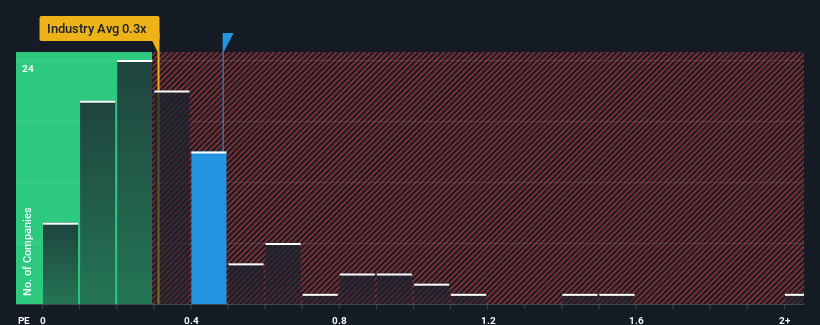- Japan
- /
- Auto Components
- /
- TSE:4231
Even With A 29% Surge, Cautious Investors Are Not Rewarding Tigers Polymer Corporation's (TSE:4231) Performance Completely
Tigers Polymer Corporation (TSE:4231) shareholders have had their patience rewarded with a 29% share price jump in the last month. The annual gain comes to 165% following the latest surge, making investors sit up and take notice.
Even after such a large jump in price, it's still not a stretch to say that Tigers Polymer's price-to-sales (or "P/S") ratio of 0.5x right now seems quite "middle-of-the-road" compared to the Auto Components industry in Japan, where the median P/S ratio is around 0.3x. Although, it's not wise to simply ignore the P/S without explanation as investors may be disregarding a distinct opportunity or a costly mistake.
Check out our latest analysis for Tigers Polymer

How Tigers Polymer Has Been Performing
Tigers Polymer has been doing a decent job lately as it's been growing revenue at a reasonable pace. One possibility is that the P/S is moderate because investors think this good revenue growth might only be parallel to the broader industry in the near future. If not, then at least existing shareholders probably aren't too pessimistic about the future direction of the share price.
Although there are no analyst estimates available for Tigers Polymer, take a look at this free data-rich visualisation to see how the company stacks up on earnings, revenue and cash flow.Is There Some Revenue Growth Forecasted For Tigers Polymer?
There's an inherent assumption that a company should be matching the industry for P/S ratios like Tigers Polymer's to be considered reasonable.
If we review the last year of revenue growth, the company posted a worthy increase of 4.1%. This was backed up an excellent period prior to see revenue up by 30% in total over the last three years. So we can start by confirming that the company has done a great job of growing revenues over that time.
Comparing that recent medium-term revenue trajectory with the industry's one-year growth forecast of 4.2% shows it's noticeably more attractive.
With this information, we find it interesting that Tigers Polymer is trading at a fairly similar P/S compared to the industry. It may be that most investors are not convinced the company can maintain its recent growth rates.
The Key Takeaway
Its shares have lifted substantially and now Tigers Polymer's P/S is back within range of the industry median. While the price-to-sales ratio shouldn't be the defining factor in whether you buy a stock or not, it's quite a capable barometer of revenue expectations.
To our surprise, Tigers Polymer revealed its three-year revenue trends aren't contributing to its P/S as much as we would have predicted, given they look better than current industry expectations. It'd be fair to assume that potential risks the company faces could be the contributing factor to the lower than expected P/S. At least the risk of a price drop looks to be subdued if recent medium-term revenue trends continue, but investors seem to think future revenue could see some volatility.
Before you take the next step, you should know about the 2 warning signs for Tigers Polymer that we have uncovered.
Of course, profitable companies with a history of great earnings growth are generally safer bets. So you may wish to see this free collection of other companies that have reasonable P/E ratios and have grown earnings strongly.
Valuation is complex, but we're here to simplify it.
Discover if Tigers Polymer might be undervalued or overvalued with our detailed analysis, featuring fair value estimates, potential risks, dividends, insider trades, and its financial condition.
Access Free AnalysisHave feedback on this article? Concerned about the content? Get in touch with us directly. Alternatively, email editorial-team (at) simplywallst.com.
This article by Simply Wall St is general in nature. We provide commentary based on historical data and analyst forecasts only using an unbiased methodology and our articles are not intended to be financial advice. It does not constitute a recommendation to buy or sell any stock, and does not take account of your objectives, or your financial situation. We aim to bring you long-term focused analysis driven by fundamental data. Note that our analysis may not factor in the latest price-sensitive company announcements or qualitative material. Simply Wall St has no position in any stocks mentioned.
About TSE:4231
Tigers Polymer
Manufactures and sells rubber hoses, sheets, and molded products primarily to automotive, electrics, construction and housing, and industrial materials markets in Japan, Southeast Asia, the Americas, and China.
Flawless balance sheet, good value and pays a dividend.
Market Insights
Community Narratives



